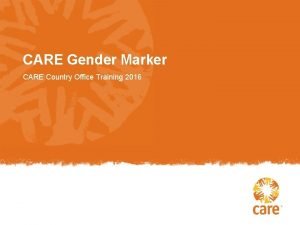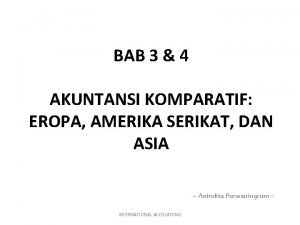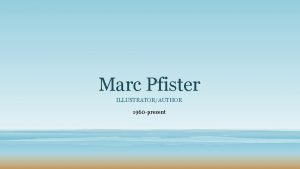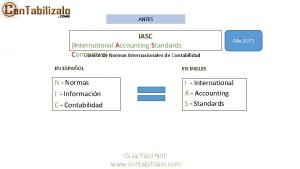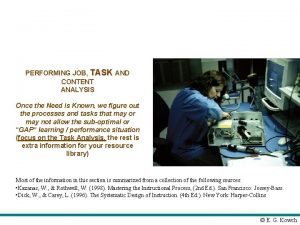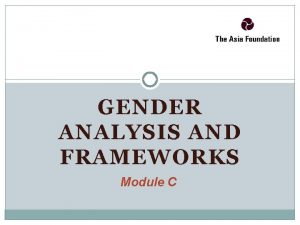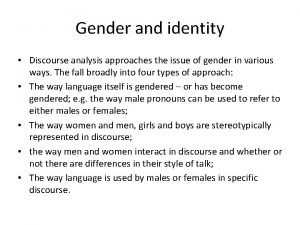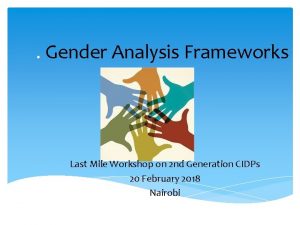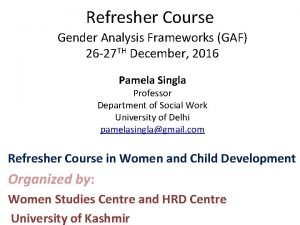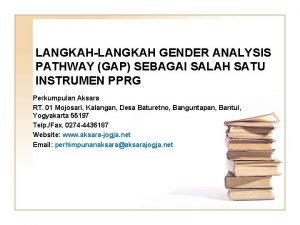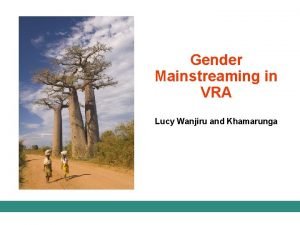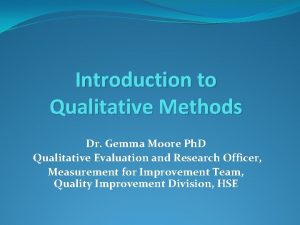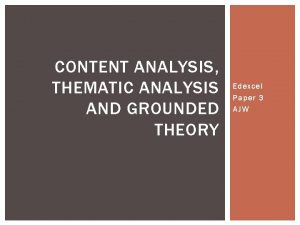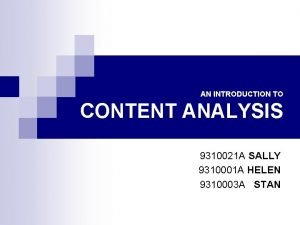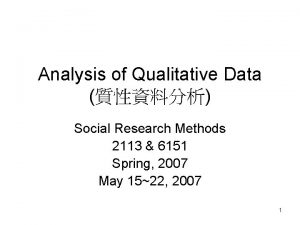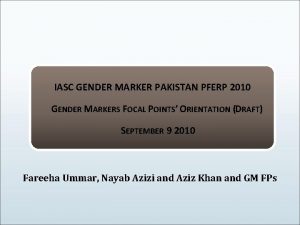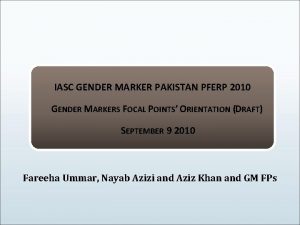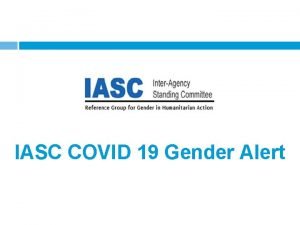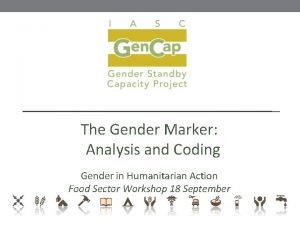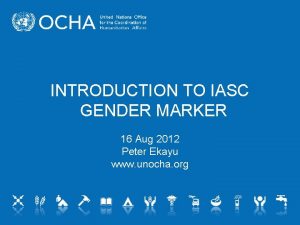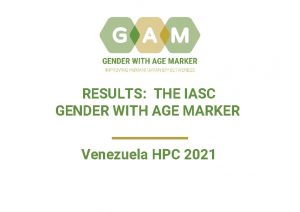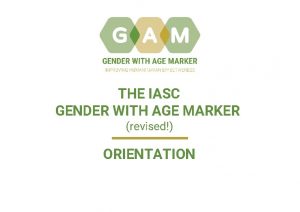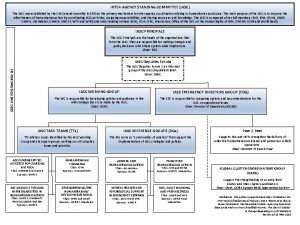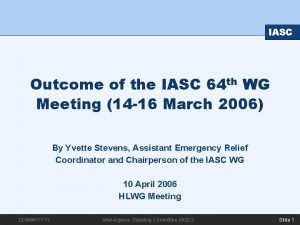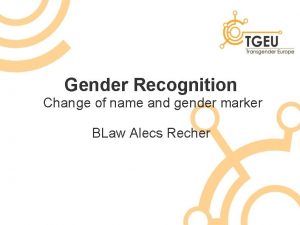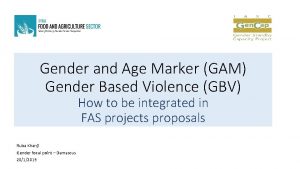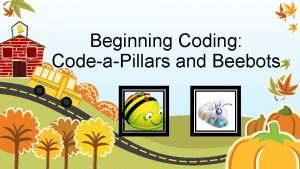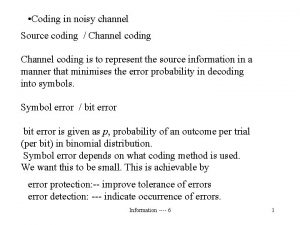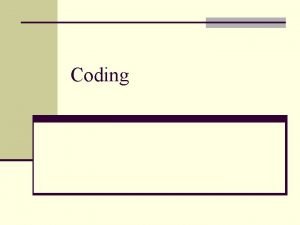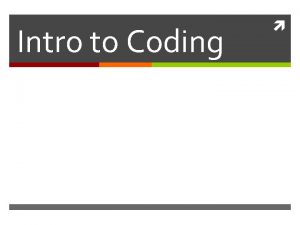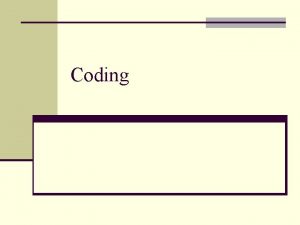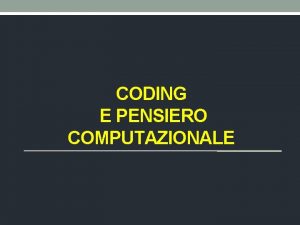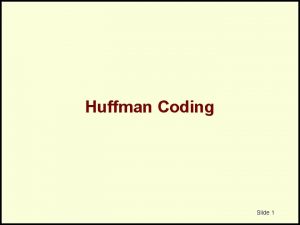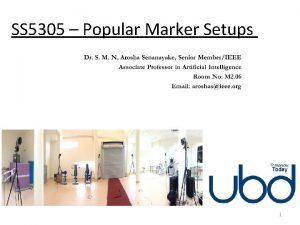IASC Gender Marker analysis and coding Content q

























- Slides: 25

IASC Gender Marker analysis and coding

Content q. Purpose of the IASC Gender Marker q. How it works q. The difference it makes q. Help…what to do when there is no gender information? q. Project design q. Resources

Purpose q Efficient and effective targeting -filling the ‘evidence gap’ q Enhances gender capacity within clusters – gender mainstreaming and better projects q Responds to donor demands and humanitarian standards. q Provides a practical tool for monitoring gender progress.

Gaining momentum q. Created by IASC CAP Sub-Working Group (humanitarian finance) collaborating with the SWG on Gender q. Piloted in in 2009; 10 countries in 2010/2011 q 20 countries in 2012 and 2013, including • 16 Consolidated Appeals (CAPs) • Five Pooled Funds and Pakistan Early Recovery Framework • Now a requirement in all humanitarian appeals and funding mechanisms.

How does it work? q a design tool - anchored in gender analysis q each humanitarian project is coded 0 -2 on its potential to advance gender equality q code based on the degree and logical flow of gender in: Needs Assessment Activities Outcomes

IASC Gender Marker Coding Gender Code Description 0 Differences between women and men are not reflected anywhere in the proposal. 1 Gender differences are reflected in only 1 or 2 critical sections* of the proposal. The project is unlikely to contribute to greater equality. 2 (2 A) Different needs and realities of women and men are described in the needs assessment (context/background) section. This analysis logically connects to project activities that address the needs of both and related outcomes. The project “mainstreams” gender and is likely to make a positive contribution to equality. (2 B) As a result of analysis, the project targets a particular group –often one sex- girls, boys, women, or men – who are disadvantaged or have distinct needs because of their gender role. The main purpose of the project is to advance equality. N/A Not Applicable This project does not have direct contact with affected populations including through employment, and does not directly affect or determine the selection or use of resources, goods or services accessed by affected populations. * One exception: If gender differences are ONLY mentioned in the Outcomes section, a project will be coded 0. Differentiated outcomes cannot happen if there has been no analysis or no intentional activities planned to achieve the outcomes.

How the Gender Marker is implemented Support to the process: q. Champions - Humanitarian Coordinator and Country Team q. Implementers - Cluster Lead Agencies and Clusters q. Cluster support - Gender Focal Point in each cluster q. Inter-cluster back-up - Gender Advisers (i. e. OCHA/UN Women/Gen. Cap) train and provide technical input to cluster Coordinators, CAP and Gender Focal Points)

Action steps – coding q. Project designers propose a gender code q. Gender Focal Points in each cluster review code and provide gender feedback to incorporate into the peer review process q. Cluster teams vet each project and provide comment on the gender content and gender code as part of feedback to each project team q. After revision, cluster teams finalize the accurate gender code and ensure this appears on OPS for each project approved in the appeal q. Cluster teams monitor and report that projects are implemented to fulfill their gender code

RESULTS: Gender Marker Trends in 6 Countries 2010 – 2013 Kenya, Niger, OPT, Somalia, Yemen, Zimbabwe

RESULTS: GLOBAL GENDER MARKER PERFORMANCE 2012 - 2013

RESULTS: 2013 Performance by Country Code 2 (A+B) 1 Sudan 74% 2 Republic of South Sudan 71% 3 Occupied Palestinian Territory 69% 4 Mauritania 66% 5 Philippines 55% 6 Burkina Faso 53% 7 Djibouti 48% 8 Somalia 47% 8 Yemen 47% 9 Kenya 46% 10 Mali 45% 11 Zimbabwe 30% 12 DRC 26% 13 Chad 19% 14 Niger 16% 15 Central African Republic 13%

RESULTS: Cluster Performance 2012 - 2013 Cluster Code 0 Code 1 Code 2 (A+B) 2012 2013 CAMP COORDINATION & MGT 0% 0% 14% 0% 86% 100% COORD & SUPPORT SVCS 13% 29% 40% 23% 48% 33% EARLY RECOVERY 8% 24% 23% 27% 69% 49% EDUCATION 1% 3% 36% 31% 63% 66% FOOD SECURITY 9% 10% 41% 40% 50% HEALTH 11% 10% 33% 39% 55% 50% LOGISTICS 27% 6% 73% 22% 0% 11% MINE ACTION 0% 0% 25% 29% 75% 71% MULTI-SECTOR: REFUGEES, ASYLUM SEEKERS, MIGRANTS 15% 7% 18% 22% 66% 70% NUTRITION 4% 10% 38% 45% 59% 45% PROTECTION 3% 5% 26% 29% 71% 65% SHELTER AND NFIs 1% 5% 41% 38% 57% WASH 6% 13% 39% 54% 48% TOTAL 7% 10% 35% 36% 58% 52%




The Successes q. Greater attention to the importance of sex- and agedisaggregated data q. Clusters establishing minimum commitments on gender q. Agencies committed to achieving 100% Code 2 projects: UNHCR, UNICEF, IOM, UNOCHA q. Country teams committing to NO gender blind ‘code 0’ projects q. Donors demanding evidence of gender responsive programming q. ECHO rolling out a Gender & Age Marker for all ECHO funded projects in January 2014

CAP 2012 Donor Survey Findings, Sept 2012 28. How valuable to you as a donor is the Gender Marker score per project? Great value 7 10 Considerable value Some value 3 7 11

Anchor: gender analysis in Needs Describe how the crisis affects women, girls, and boys differently: q Their diversity. Who may be overlooked? q What has changed? q Are they safe or at risk? q Who cannot access service? q What are their roles? Skills? q How do they cope? q Who makes decisions ? q Who is subject to violence? Who perpetrates violence?

Practice coding –nutrition (code 1 Why? ) Needs • Y# children U 5 and X# pregnant and lactating women are estimated (source given) at risk of acute malnutrition Activities • Screening , therapeutic feeding, supplementary feeding , micronutrients/Vitamin A for U 5 children (target # for each) • Breastfeeding activities, micronutrients/Vitamin A for # PLW Outcomes • Nutrition level of # of U 5 children stabilized-no increase in malnutrition • # PLW receive nutrition needed for selves and infants

Agriculture /ER (code 2 a – Why? ) Needs • Rubble removal and land restoration; seed and tools for planting rice and vegetables; pre-crisis data showed men invest circa X% in-field work in rice, women Y% & vegetable gardens use predominantly women’s labour, men do land preparation. Both active in land clearance and recycling – in single-sex FGDs men and women each identify what they have skills to do and want to do in rubble removal/land restoration OR market traders in nearby towns identified tools commonly used by men/women Activities • Appropriate tools and seeds distributed for #% men%women • Cf. W for # people (%men%women) reflecting their preferences Outcomes • Cf. W allows X# (%men%women) in vulnerable families to……… • X# men Y# women planted crops on time using appropriate tools and seeds

Shelter (code 1 – Why? ) Needs • X totally damaged & Y partially damaged houses (source); protection risks reported especially for women and girls so need for safe shelter solutions (source); repair kits and NFIs for temporary shelter for # families (source); proxy estimate made of # single HHs and child-headed HHs Activities • Provision of tarpaulins, tool kits • Provision of Cf. W for X people • Youth brigades (half male/half female) organized to help vulnerable HHs, including single HHs, to set up temporary shelter Outcomes • # families have temporary shelter providing privacy and protection from the weather • # people benefit from Cf. W ……….

Tips for good projects • Evidence - gender and social analysis • Source - single-sex FGDs; assessments; field observations; secondary data • Input from target males and females – single-sex FGDs • No cosmetics • Clear results for women and for men, for girls and for boys as appropriate

Resources http: //www. humanitarianresponse. info → crosscutting issues → gender q Gender Tipsheets (Sector-specific guidance for incorporating gender, in 4 languages), FAQs, and Gender Marker materials q Gender Handbook in Humanitarian Action in 7 languages q Guidelines for Gender-based Violence Interventions in Humanitarian Settings q Link to IASC gender e-learning course www. iascelearning. org Trailer for the Gender Handbook (opening video) is available at http: //vimeo. com/7296455 or (lower resolution) http: //vimeo. com/7310380


Cluster Response Plan – Gender Marker – Traffic Lights q. Evidence the different needs and capacities of men, women, girls and boys are starting to be identified, some information/data is given, AND there are convincing assurances that the cluster will explore, increasingly understand incorporate gender dimensions into its response q. Commitment that SADD will be collected and used by the cluster partners Red: needs improvement Yellow: on the way Green: getting it right
 Open coding axial coding selective coding
Open coding axial coding selective coding Contoh open coding axial coding selective coding
Contoh open coding axial coding selective coding Care gender marker
Care gender marker Akuntansi komparatif
Akuntansi komparatif T-iasc ildathach marcus pfister
T-iasc ildathach marcus pfister Iasc aneel
Iasc aneel Contabilizalo.com
Contabilizalo.com Strategic gender needs and practical gender needs
Strategic gender needs and practical gender needs Coding dna and non coding dna
Coding dna and non coding dna History of qualitative research
History of qualitative research Carrier content and real content in esp
Carrier content and real content in esp Discourse analysis vs content analysis
Discourse analysis vs content analysis Job content analysis
Job content analysis Static content vs dynamic content
Static content vs dynamic content Secondary content analysis
Secondary content analysis Parts of gender analysis framework
Parts of gender analysis framework Gender discourse analysis
Gender discourse analysis Lie of the land
Lie of the land Moser framework tools
Moser framework tools Contoh gender analysis pathway (gap)
Contoh gender analysis pathway (gap) Gender analysis example
Gender analysis example Difference between thematic and content analysis
Difference between thematic and content analysis Difference between thematic and content analysis
Difference between thematic and content analysis Content and discourse analysis
Content and discourse analysis Strengths and weaknesses of content analysis
Strengths and weaknesses of content analysis Qualitative data analysis coding
Qualitative data analysis coding


